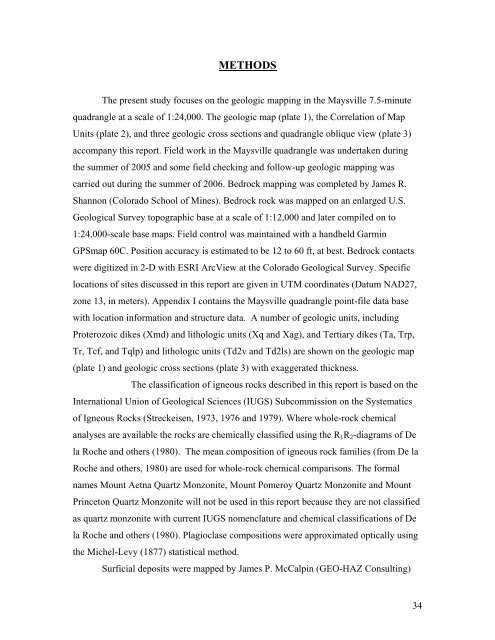Geologic Map of the Maysville Quadrangle, Chaffee County, Colorado
Geologic Map of the Maysville Quadrangle, Chaffee County, Colorado
Geologic Map of the Maysville Quadrangle, Chaffee County, Colorado
You also want an ePaper? Increase the reach of your titles
YUMPU automatically turns print PDFs into web optimized ePapers that Google loves.
METHODS<br />
The present study focuses on <strong>the</strong> geologic mapping in <strong>the</strong> <strong>Maysville</strong> 7.5-minute<br />
quadrangle at a scale <strong>of</strong> 1:24,000. The geologic map (plate 1), <strong>the</strong> Correlation <strong>of</strong> <strong>Map</strong><br />
Units (plate 2), and three geologic cross sections and quadrangle oblique view (plate 3)<br />
accompany this report. Field work in <strong>the</strong> <strong>Maysville</strong> quadrangle was undertaken during<br />
<strong>the</strong> summer <strong>of</strong> 2005 and some field checking and follow-up geologic mapping was<br />
carried out during <strong>the</strong> summer <strong>of</strong> 2006. Bedrock mapping was completed by James R.<br />
Shannon (<strong>Colorado</strong> School <strong>of</strong> Mines). Bedrock rock was mapped on an enlarged U.S.<br />
<strong>Geologic</strong>al Survey topographic base at a scale <strong>of</strong> 1:12,000 and later compiled on to<br />
1:24,000-scale base maps. Field control was maintained with a handheld Garmin<br />
GPSmap 60C. Position accuracy is estimated to be 12 to 60 ft, at best. Bedrock contacts<br />
were digitized in 2-D with ESRI ArcView at <strong>the</strong> <strong>Colorado</strong> <strong>Geologic</strong>al Survey. Specific<br />
locations <strong>of</strong> sites discussed in this report are given in UTM coordinates (Datum NAD27,<br />
zone 13, in meters). Appendix I contains <strong>the</strong> <strong>Maysville</strong> quadrangle point-file data base<br />
with location information and structure data. A number <strong>of</strong> geologic units, including<br />
Proterozoic dikes (Xmd) and lithologic units (Xq and Xag), and Tertiary dikes (Ta, Trp,<br />
Tr, Tcf, and Tqlp) and lithologic units (Td2v and Td2ls) are shown on <strong>the</strong> geologic map<br />
(plate 1) and geologic cross sections (plate 3) with exaggerated thickness.<br />
The classification <strong>of</strong> igneous rocks described in this report is based on <strong>the</strong><br />
International Union <strong>of</strong> <strong>Geologic</strong>al Sciences (IUGS) Subcommission on <strong>the</strong> Systematics<br />
<strong>of</strong> Igneous Rocks (Streckeisen, 1973, 1976 and 1979). Where whole-rock chemical<br />
analyses are available <strong>the</strong> rocks are chemically classified using <strong>the</strong> R 1 R 2 -diagrams <strong>of</strong> De<br />
la Roche and o<strong>the</strong>rs (1980). The mean composition <strong>of</strong> igneous rock families (from De la<br />
Roche and o<strong>the</strong>rs, 1980) are used for whole-rock chemical comparisons. The formal<br />
names Mount Aetna Quartz Monzonite, Mount Pomeroy Quartz Monzonite and Mount<br />
Princeton Quartz Monzonite will not be used in this report because <strong>the</strong>y are not classified<br />
as quartz monzonite with current IUGS nomenclature and chemical classifications <strong>of</strong> De<br />
la Roche and o<strong>the</strong>rs (1980). Plagioclase compositions were approximated optically using<br />
<strong>the</strong> Michel-Levy (1877) statistical method.<br />
Surficial deposits were mapped by James P. McCalpin (GEO-HAZ Consulting)<br />
34




